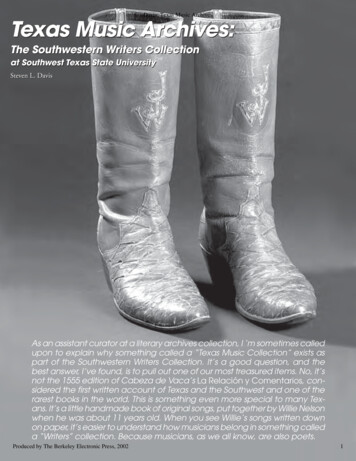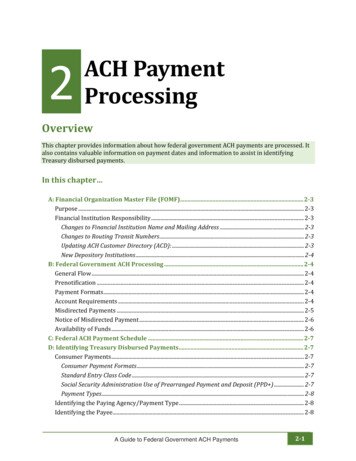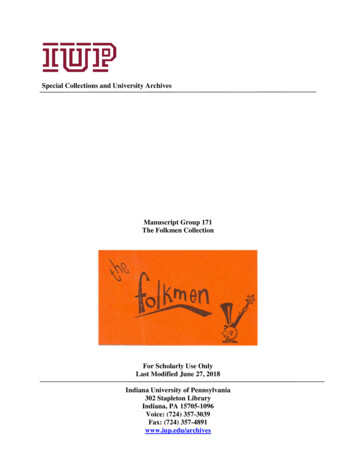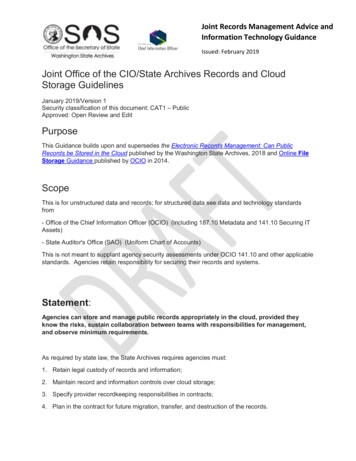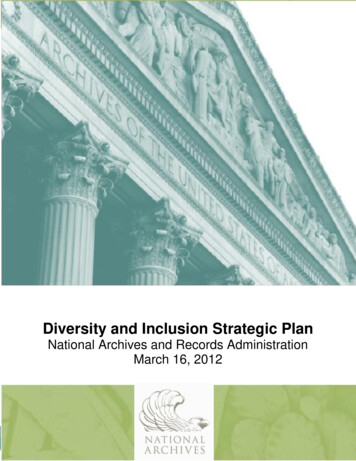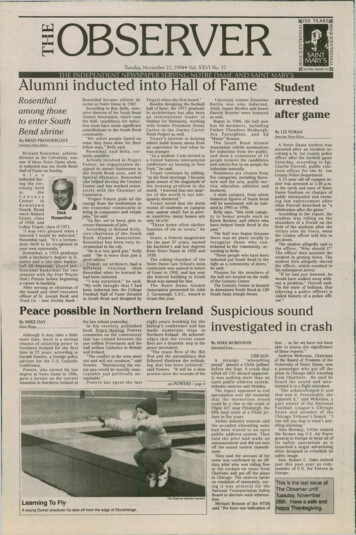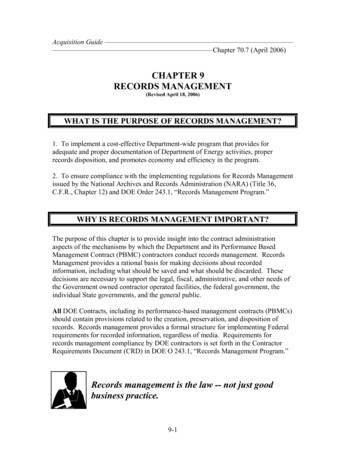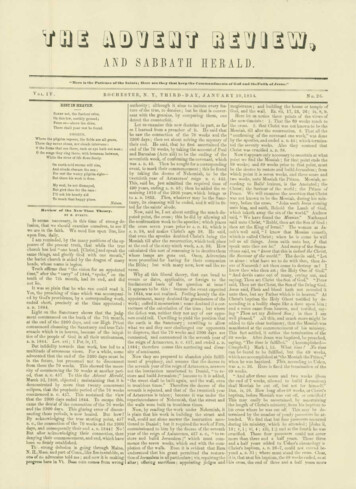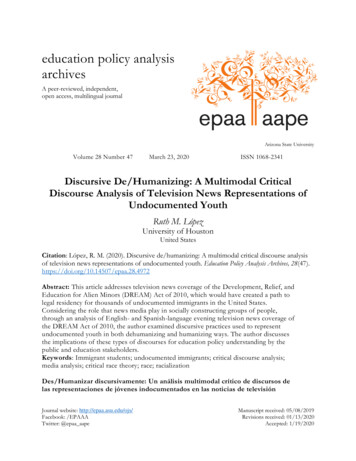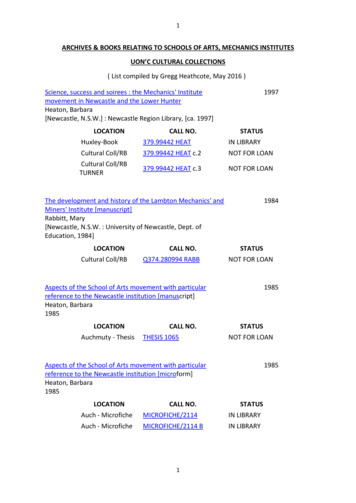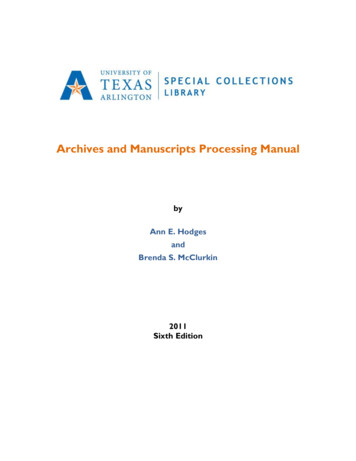
Transcription
Archives and Manuscripts Processing ManualbyAnn E. HodgesandBrenda S. McClurkin2011Sixth Edition
Table of ContentsIntroduction . iiiChapter 1: Basic Principles of Processing . 1Chapter 2: Accessioning . 4Chapter 3: Arrangement .12Chapter 4: Preservation .24Chapter 5: Description .35Chapter 6: Cataloging Form.50Chapter 7: Publicity .62Appendices .67Forms . 68Supplemental Material. 94Sample Finding Aid . 107Bibliography. 116Webography . 119Index . 120
Introduction to the 6th EditionPage iiiIts 6th edition brings the Archives and Manuscripts Processing Manual online. The changesin the new edition primarily comprise the addition to Chapter 4 of instructions forencapsulating using the polywelder (no other substantive revisions were made to thechapters) and the inclusion of several new forms.The Agreement to Donate Student Work form was designed to provide documentation ofdonations of student research papers to Special Collections. The Conservation Requestform was created to guide staff through the process of routing materials for repair. TheFinding Aid Template was designed to guide and speed students in Dean Saxon's archivesclass in the preparation of their finding aids, but benefits our staff as well. It gives findingaid authors more structure when compiling information for a finding aid and eliminates theneed to format finding aids in a word-processing program. These improvements have thefurther advantage of enabling Special Collections staff to publish finding aids with lesseffort and in less time because, thanks to having the finding aid drafts formatted as tables,we are able to easily use "search and replace" to apply EAD markup.Oral History Agreements have been used in Special Collections for some years, for boththe subjects of interviews and those conducting the interviews, but were not included inthe Processing Manual until this edition. The creation of the Restriction Release Requestwas prompted by the need of one of our researchers to obtain access to a restrictedcollection for his dissertation research. Happily, permission was obtained and hesuccessfully defended his dissertation, and we will be able to apply for the next releasemore efficiently now that we have the form.The Donor Information form that appears in this edition has been heavily revised sincethe publication of the 5th edition. Links have been updated in the lists of perpetualcalendars and of sources of equipment and supplies, as well as in the Bibliography andWebography. Finally, Special Collections' Archives and Manuscripts DeaccessioningPolicy has been added to this manual.Thanks are owed once again to Claire Galloway, CA, for helping to identify the updatesneeded since the publication of the 5th edition of the Archives and Manuscripts ProcessingManual and for suggesting the creation of the Agreement to Donate Student Work and theRestriction Release Request. If it were not for Gerald Saxon and his Principles of Archivesand Museums course at the University of Texas at Arlington this edition would no doubtstill be pending.Ann E. Hodges, MLS, MS, CABrenda S. McClurkin, MLS, CA
Introduction to the 5th EditionPage ivWe would like to acknowledge and thank Gerald D. Saxon, Jane Boley, Marcelle Hull, ShirleyRodnitzky, and Cynthia E. Stevenson, all formerly on staff in Special Collections, whoauthored the earlier editions of the Archives and Manuscripts Processing Manual. Theirwork is described in the introduction to the 4th edition, which is incorporated in thepresent edition. It explains how and why the first manual came to be written and alsorelates the philosophy underlying the manual as well as a bit of the history of SpecialCollections. We also extend our appreciation to the newest archivist in Special Collections,Claire Galloway, and to Gerald Saxon, both of whom read and commented upon our draft.The work our predecessors invested in earlier editions of the Processing Manual has beenof enormous benefit to numbers of students in the archival education program at TheUniversity of Texas at Arlington, as well as to Special Collections staff through the years.Special Collections' Processing Manual has even been in demand by archivists at otherinstitutions and in other states.The years between the publication of the 4th edition and that of the 5th saw changes ofmonumental impact in the archives profession, encompassing the advent of EncodedArchival Description, the replacement of Archives, Personal Papers and Manuscripts withDescribing Archives: A Content Standard, and the increasing adoption of minimal-levelprocessing. In 2002, Special Collections became a member of Texas Archival ResourcesOnline (TARO), a consortial repository of finding aids. Our implementation of the newstandards and practices naturally resulted in substantial alterations to Special Collections'policies and procedures relating to the processing of archives and manuscript collections.Consequently, the revisions we made to the Processing Manual were exhaustive, amountingin essence to a rewriting of the manual, especially the sections concerning description.Contributing to the changes made to the manual was our desire for it to become primarilyan online resource. However, a print version was also needed for use by archives studentsduring their practical sessions. With both aims in mind, we endeavored to simplify thepresentation of forms and other supplemental material by placing as much of it as possibleat the end of the manual, rather than embedding it within chapters, envisioning itsbecoming accessible via links in the online version.We hope that our efforts on the new manual honor the work that was done before us. Itwas our aim to uphold the purposes set out for the original and to be of as much aid tostudents and colleagues as were the authors of the previous editions.Ann E. Hodges, MLS, MS, CABrenda S. McClurkin, MLS, CA
Introduction to the 4th EditionPage vThe Special Collections Division of The University of Texas at Arlington Libraries has beencollecting archival and manuscript materials since the 1960s. In this twenty-five-plus yearperiod, the division has grown from a two-person operation collecting and processing therecords of Texas labor unions and officials to a highly visible division of the library with tenfull-time staff, seven student employees, and a much broadened collecting focus. Alsoduring this period, the division has grown, extending its administrative umbrella overseveral once-separate and autonomous units, each processing archival and manuscriptcollections in its own way. The need to bring consistency to the division's archivalarranging, describing, and cataloging practices has, in part, prompted the writing of thisprocessing manual.In 1994, Special Collections staff members, Jane Boley, Marcelle Hull, Shirley Rodnitzky,and Gerald Saxon, met to discuss the drafting of this manual. All agreed that a processingmanual would benefit the division in many ways:The manual, as mentioned above, would bring consistent processingpractices to the division for the first time. Special Collections staff has alwaysadhered to high standards of modern archivy, but each archivist in thedivision described collections in a different way. In today's automatedenvironment, descriptive practices in particular should be consistent so thatonline cataloging records and finding aids are helpful to users.The manual would serve as a training tool and reference source for thedivision's student employees, volunteers, and new hires assigned archivalresponsibilities.The manual would be used as a textbook in the History Department'sgraduate classes on archival science. The holdings of Special Collections areoften used for processing projects by graduate students in the program. Theprocessing manual, used as a textbook for graduate students in the archivesclass, will ensure that their processing is consistent with the division'sstandards and methods.The processing manual, then, will have both an internal function (for Special Collections'students and staff) and an external one (for UTA graduate students). Moreover, theauthors of the manual realize that it is an organic document, one subject to change andrevision as archival practices shift and new methods and technologies are introduced.What probably will not change are the underlying assumptions the authors brought to themanual's writing. The reader should be aware that these assumptions include thefollowing:1. The ideal level of processing is not the same for every collection. It is theprocessor's responsibility to determine the most practical processingscheme.
Introduction to the 4th EditionPage vi2. The research value of each collection should determine its level ofprocessing.3. Staff should do only enough work on collections to make them usable forresearchers.4. The archival principles of provenance and original order shoulddetermine arrangement.5. It is unlikely that any collection will ever be "reprocessed" so processorsshould consider their work on each collection to be final.6. The manual is designed as a guide. It cannot answer every question orconsider every possibility in the archival enterprise. Processors withquestions not addressed in the manual should consult their colleagues onthe staff or in the broader archival community.7. The overall goals in processing are to preserve the material withenduring value in the collection, arrange the collection in a logical way,describe the arrangement in a well-written finding aid, and make sure allappropriate forms are completed.Special Collections is committed to providing effective access to all of its holdings andactively encourages its collections be used. In order to provide the best possible service tousers, it is important that as many of our collections as possible be processed, open, andavailable for research. Processors must always keep in mind that they should not do morework on a collection than is necessary to make it usable because the extra work done onone collection will detract from the work that can be done on others. While many have saidthat processing is largely a matter of common sense, the authors of the manual believe thatthe procedures and methods discussed herein will make our processing methods moreefficient, more consistent, and ultimately, of course, more helpful to researchers.This processing manual has served Special Collections staff and others well since it wasfirst produced in 1995. It has gone through several revisions, as text was clarified, typoscorrected, new procedures and practices incorporated, and archival standards havechanged. The manual, until now (2001), has never been available electronically. Webelieve by making the manual available over the UTA Libraries web page that practicingarchivists at UTA and beyond can benefit as will graduate students and others. Specialthanks must go to Shirley Rodnitzky, who coordinated the efforts in Special Collections torevise the manual yet again and to see that it is mounted on the web.Gerald D. Saxon, Associate Director of LibrariesNovember 28, 2000
Chapter 1: Basic Principles of ProcessingPage 1When processing an archival collection, an archivist must survey and evaluate a collectionto determine its content and structure. A few basic principles and concepts guidearchivists in this work.Provenance: Simply defined, provenance means that the archives of a given recordscreator must not be intermingled with those of other records creators. Archivist FredricMiller has said that "provenance is the fundamental principle of modern archival practice."It is important to understand that provenance is identified primarily with the creatorrather than the donor, if the two are different. For example, if Jane Smith donated thepapers of her grandmother, Sarah Norton, the papers would be the Sarah Norton Papersbecause she created them.Original Order: This principle states that records should be maintained in the order inwhich they were originally kept while in active use. It is not the order imposed on thematerial by someone who was not involved with the records while they were in active use.If the order has been destroyed over time or in the transfer/packing process, then it is thearchivist's obligation to reconstitute it if possible. If the original order of a collectioncannot be discerned or if the original order was capricious and incomprehensible, then thearchivist must impose a reasonable and logical order on the collection.Respect des Fonds: Describing Archives: A Content Standard defines this principle asmeaning that "the records created, assembled, accumulated, and/or maintained and usedby an organization or individual must be kept together (i.e. identified as belonging to thesame aggregation) in their original order, if such order exists or has been maintained. Theyought not be mixed or combined with the records of another individual or corporate body."DACS presents the concepts of provenance and original order as sub-principles of respectdes fonds.Levels of Arrangement: The concept of levels of arrangement is not a theoreticalprinciple, but rather a way of implementing administrative and intellectual control in themanagement and processing of records. Perhaps best explained by Oliver Wendell Holmes,the concept recognizes that most modern archival work involves progressively groupingand describing sets of records along a continuum, going from the largest and most generalto the smallest and most specific. Not all collections need to be arranged and described atthe same level. The collection's size, research value, basic structure, and other factors willdictate the level to which it should be arranged and described. The various levels ofarrangement are:Collection Level: Generally, small collections, more than large ones, lendthemselves to a single arrangement and can be described adequately at thecollection level. Single items maintained as discrete collections, such as adiary, ledger book, scrapbook, etc., also should be described at the collectionlevel.
Chapter 1: Basic Principles of ProcessingPage 2Series Level: A series consists of records that form a discrete group. Thisgroup may comprise a discernable filing system (arranged alphabetically,chronologically, numerically, topically, or some combination of these) or itmay be a grouping of records based on similar function, content, genre ordocument type. In any case, the series level is probably the most importantone in arrangement because in the establishment of series the archivistexpresses the character of the collection. Processing depends largely onestablishing series for collections or uncovering the series that the recordscreator used. The series cannot be identified until the archivist has studiedthe entire collection. After the series in a collection have been determined,the archivist arranges them by placing the most important one first, followedby the others in descending order of importance. A series may also bedivided into subseries based on the criteria listed above. See thediagram at the end of this chapter for examples of subseries.File Unit Level: A file unit is an aggregation of documents brought together,usually for convenience in filing, in such a way that the documents may betreated as a unit. File units are often placed in chronological sequence whenthey document a regular activity, such as minutes of meetings. The ordermay be alphabetical when the units document programs, topics,organizations, or people; for example, case files arranged by the name of theclient or correspondence arranged by the name of the recipient of the letter.The arrangement of file units may also be by some internal classificationsystem, usable only if the archivist can find a key or codebook to the system.The individual documents within each unit must also be logically arranged,depending upon the level at which the collection is being processed.Item Level: An item is a single document or manuscript within a collection. Thearchivist is more likely to arrange and/or describe a collection at the item level if thecollection is small, of high importance, or has lost its original order. Single items areplaced together in file units. Generally, items in files have either a chronological oralphabetical arrangement, or a combination thereof. For example, if one has a seriesof correspondence, arranged alphabetically in file units by the name of the party towhom the correspondence is addressed, then the letters in each file unit wouldprobably be arranged in chronological order. While archivists sometimes have tohandle and arrange every item in a collection, it is extremely rare that they describea collection at the item level, unless the collection is very small or very important.Time constraints restrict the description of a collection at such a minute level.
Chapter 1: Basic Principles of ProcessingCOLLECTIONJONES PAPERSSERIESSUBSERIESFILE UNITITEMPage 3CorrespondenceReceived19101911Jan 1 Mar 31 Apr 4 Oct 25Financial DocumentsSentA-LM-TWilsonAdams LaleMills TaftMay 1 June 2LedgerBillsReceiptsLedgerBillsReceiptsLedger Acme Shepherd Mills TaftMarch 2nd ParadeMusicMarchesPersonnelRightsCharge Dixie DeccaPersonnelMGMRobertsSmit
Chapter 2: AccessioningPage 4Incoming archives and manuscript collections are accessioned to obtain basic intellectualcontrol over the material. Each collection added to Special Collections should beaccessioned according to the steps outlined below.Registration1. Register the collection by entering the following information in the Accession Log. date collection received accession number (use next available number) brief description of the materials name of donor or source of the materials extent of the collection (number of items or boxes and linear footage) acquisition method (gift, transfer, or price if purchased) intended location (GA or AR) dates transfer of title was sent to and received from the donor existence of restrictions imposed on the collection (yes or no) date when any restrictions expire collection number when one has been assignedAccession numbers consist of two components: a four-digit number representing theyear and a consecutive number indicating the
form was created to guide staff through the process of routing materials for repair. The . and an external one (for UTA graduate students). Moreover, the authors of the manual realize that it is an organic document, one subject to change and . If the order has been destroyed over ti
